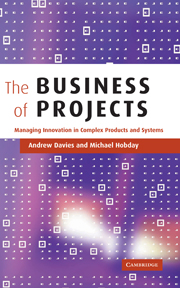Book contents
- Frontmatter
- Contents
- List of figures
- List of tables
- Foreword
- Acknowledgements
- Glossary
- 1 Introduction
- 2 The dynamics of innovation in complex products and systems
- 3 Business strategy and project capability
- 4 Systems integration and competitive advantage
- 5 The project-based organisation
- 6 Managing software-intensive projects
- 7 Learning in the project business
- 8 Integrated solutions for customers
- 9 Lessons for the project business
- Appendix A
- Appendix B
- Appendix C
- References
- Index
1 - Introduction
Published online by Cambridge University Press: 22 September 2009
- Frontmatter
- Contents
- List of figures
- List of tables
- Foreword
- Acknowledgements
- Glossary
- 1 Introduction
- 2 The dynamics of innovation in complex products and systems
- 3 Business strategy and project capability
- 4 Systems integration and competitive advantage
- 5 The project-based organisation
- 6 Managing software-intensive projects
- 7 Learning in the project business
- 8 Integrated solutions for customers
- 9 Lessons for the project business
- Appendix A
- Appendix B
- Appendix C
- References
- Index
Summary
Between firms and markets
Projects are becoming key to the growth, profitability and survival of the firm in an increasingly competitive and global business environment. Consultancy organisations, film makers, defence contractors, civil engineering companies, oil and gas producers, advertising agencies, and manufacturers of trains, aerospace and telecoms systems are all project businesses. They use projects to handle most of their internal needs as well as customer-facing activities such as product or process innovation, delivering major capital projects, promoting organisational renewal, and exploring new technology and market opportunities.
Today, firms in all types of industries are finding that traditional organisations, including functional departments, business units and divisions, are stifling innovation. Set up as permanent or semi-permanent structures, these organisational forms are suited to maintaining high-volume throughputs of standardised products and services and to making repetitive decisions in a relatively stable technological and market environment. But in a rapidly changing, uncertain and often turbulent environment, firms face many one-off opportunities and unique problems that cannot be dealt with easily by permanent or semi-permanent organisations. They are discovering that a one-off temporary problem or opportunity requires a one-off or temporary project organisation to resolve it.
In contrast to the hierarchical and mechanistic management structures used in functional organisations, a project brings people together in an organic, adaptive and flatter structure (Bennis, 1966; Bennis and Slater, 1968) – or adhocracy, a term popularised by Alvin Toffler (1970) – that is able to innovate around specific customer needs in fast-changing conditions.
- Type
- Chapter
- Information
- The Business of ProjectsManaging Innovation in Complex Products and Systems, pp. 1 - 19Publisher: Cambridge University PressPrint publication year: 2005

